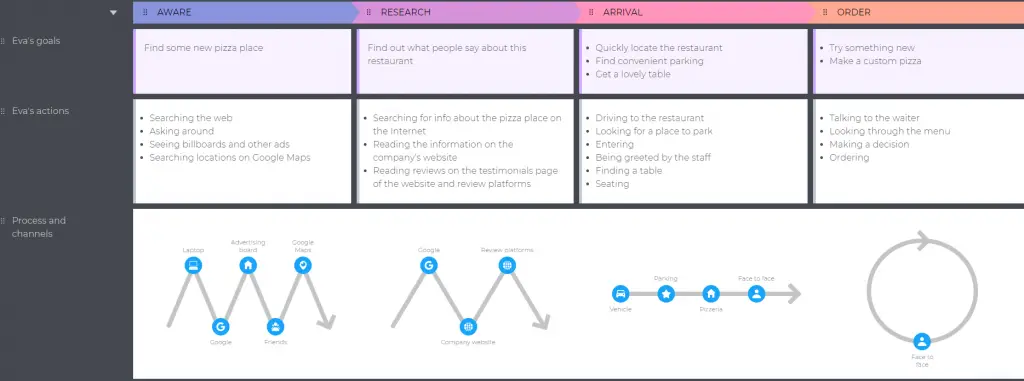User experience (UX) is like a first date. Just as a bad first date can leave you feeling frustrated and unfulfilled, a poorly designed user experience can leave your customers feeling frustrated and unfulfilled too.
But fear not! In this article, we’ll explore the importance of user experience, how it impacts customer satisfaction as well as tools that will empower you in designing better user experiences. So sit back, relax, and let’s get into it.
First, what is the user experience?
At its core, UX is all about how a user interacts with a product or service. This can range from a website to a physical product, and everything in between. A good user experience is one that is seamless, intuitive and enjoyable.
It should make the user feel confident and in control, and should ultimately help them achieve their goals with ease.
UX (User Experience) and CX (Customer Experience) are closely related and have a significant impact on each other. When a user has a positive UX, it can lead to a positive CX. For example, if a user finds a website easy to navigate, fast to load, and visually appealing, they are more likely to have a positive experience with the brand overall.
So why is UX so important?
Well, let’s think about it this way: when was the last time you used a product or service that frustrated you? Maybe it was a website that was difficult to navigate or a phone menu that left you stuck in an endless loop. How did it make you feel? frustrated? Annoyed? angry? Now, imagine that feeling multiplied by a thousand. That’s how your customers will feel if your user experience is subpar.
On the other hand, a good user experience can do wonders for customer satisfaction. When a customer feels in control and is able to achieve their goals with ease, they are more likely to feel positive about your brand. This can lead to increased loyalty, positive word-of-mouth, and ultimately, more sales.
But how do you create a good user experience?
Well, that’s the million-dollar question. There’s no one-size-fits-all answer, as each product or service is unique. However, there are some general principles that can help guide you in the right direction. These include:
- Simplicity – Keep things as simple as possible. Don’t overwhelm your users with too many options or features.
- Clarity – Make sure everything is easy to understand. Use clear language and intuitive design.
- Consistency – Keep things consistent throughout your product or service. This helps users feel more in control.
- Feedback – Provide feedback to your users so they know what’s happening. Don’t leave them guessing.
- Testing – Test your user experience with real users. This will help you identify any pain points or areas for improvement.
By focusing on these principles, you can create a user experience that delights your customers and keeps them coming back for more.
Examples of how user experience impacts customer satisfaction:
Apple’s iPhone

Apple’s iPhone is known for its intuitive user interface and sleek design. Everything is designed to be simple and easy to use, from the lock screen to the home screen to the individual apps. This has helped Apple to create a loyal customer base that is willing to pay a premium for its products.
Amazon’s One-Click Ordering:
Amazon’s One-Click Ordering is a simple feature that allows customers to purchase products with just one click. This eliminates the need to go through a long checkout process, making the experience faster and more enjoyable. As a result, customers are more likely to purchase and return to Amazon in the future.
Google’s Search Engine
Google’s search engine is designed to provide the most relevant results to users based on their search queries. The user interface is simple and easy to use, allowing users to quickly find the information they are looking for.
This has made Google the most popular search engine in the world, with billions of users every day.
Southwest Airlines Mobile App
Southwest Airlines’ mobile app is designed to make the booking and check-in process as easy as possible. Customers can quickly book flights, select seats, and check in for their flights, all from their mobile devices. This has helped Southwest to create a loyal customer base that values the convenience of their mobile app.
Tesla’s Autopilot

Tesla’s Autopilot feature is designed to make driving easier and safer. The features include automatic steering, acceleration, and braking, allowing drivers to relax and enjoy the ride. This has helped Tesla to create a loyal customer base that values the safety and convenience of its vehicles.
3 UX Tools For Better Experiences
Designing a great user experience is key to the success of any brand or product. Fortunately, there are many UX tools available that can help brands create better experiences for their customers. Here are some UX tools that can help brands design better experiences:
Figma
Figma is a cloud-based design tool that allows designers to create and collaborate on wireframes, prototypes, and high-fidelity designs in real-time. It also includes a library of pre-made UI components that can be used to speed up the design process.
InVision
InVision is a design collaboration tool that allows designers to create prototypes and share them with other team members for feedback. It also includes features for user testing and design handoff.
UserTesting
UserTesting is a user research platform that allows brands to get feedback on their products or prototypes from real users. This feedback can be used to improve the user experience and create a product that better meets the needs of customers.
UXPressia

UXPressia is another UX tool that can help brands design better experiences. It is a suite of tools that includes customer journey mapping, persona creation, and stakeholder mapping. Here’s how UXPressia can help brands:
- Customer Journey Mapping: With UXPressia’s customer journey mapping tool, brands can visualize the steps that customers take as they interact with their products or services. This tool can help brands identify pain points in the customer journey and find ways to improve the overall experience.
- Persona Creation: UXPressia’s persona creation tool allows brands to create detailed personas representing their target audience. These personas can include information such as demographics, behaviors, goals, and pain points. This tool can help brands create products and services that better meet the needs of their customers.
- Stakeholder Mapping: UXPressia’s stakeholder mapping tool allows brands to visualize the relationships between different stakeholders in their organization. This tool can help brands identify areas of overlap or conflict between stakeholders, and find ways to create alignment and collaboration.
Overall, UXPressia is a powerful tool for brands that want to create better user experiences. By using customer journey mapping, persona creation, and stakeholder mapping, brands can better understand their customers and stakeholders, and design products and services that meet their needs.
In conclusion, user experience is crucial to customer satisfaction. A good user experience can make all the difference, while a bad one can leave your customers feeling frustrated and unfulfilled.
By focusing on simplicity, clarity, consistency, feedback, and testing, you can create a user experience that delights your customers and helps your brand stand out from the crowd. So go forth and create an experience your customers will love.
Free bonus: You can download this guide as PDF. Easily save it on your computer for quick reference or print it out to share with others in your team –
User Experience: How It Impacts On Customer Satisfaction And 4 UX Tools To Design Better Experiences.pdf
